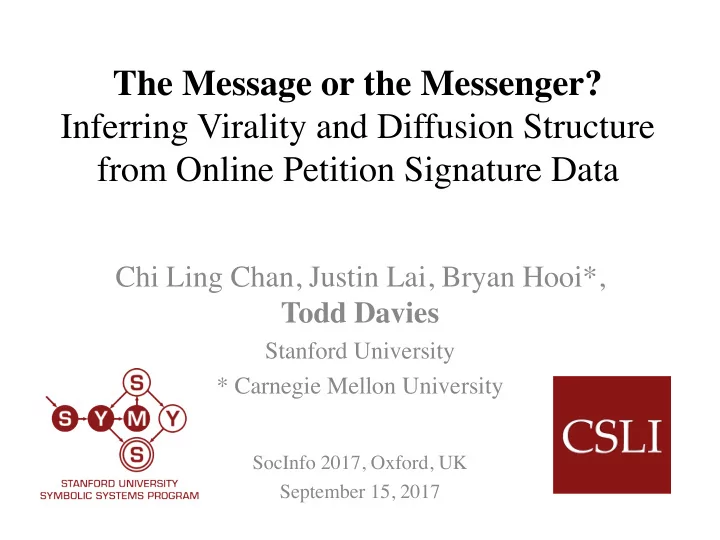

The Message or the Messenger? Inferring Virality and Diffusion Structure from Online Petition Signature Data Chi Ling Chan, Justin Lai, Bryan Hooi*, Todd Davies Stanford University * Carnegie Mellon University SocInfo 2017, Oxford, UK September 15, 2017
From https://upload.wikimedia.org/wikipedia/commons/7/72/Du ncan_Watts.jpg
Viral marketing (Faberge shampoo ad, 1982)
The classical adoption pattern Graph from https://commons.wikimedia.org/wiki/File:Diffusionofideas.PNG
Schematic diffusion patterns Broadcast Viral Message is important (?) Messenger is important Fig. 1 from Goel et al. (2016), “The Structural Virality of Online Diffusion” (https://cs.stanford.edu/people/ashton/pubs/twiral.pdf)
Structural virality as the Wiener index (Goel, Anderson, Hofman, & Watts 2016) v(T) = the average distance between all pairs of nodes in a diffusion tree T (or, equivalently, the average depth of all nodes as roots) for n > 1 nodes d ij = the shortest distance between nodes i and j
Random Twitter cascades ordered by structural virality Fig. 3 from “The Structural Virality of Online Diffusion” (https://cs.stanford.edu/people/ashton/pubs/twiral.pdf)
Structural virality by cascade size/popularity on Twitter, per domain Fig. 5 from “The Structural Virality of Online Diffusion” (https://cs.stanford.edu/people/ashton/pubs/twiral.pdf)
Correlation between popularity and structural virality for 4 domains Fig. 6 from “The Structural Virality of Online Diffusion” (https://cs.stanford.edu/people/ashton/pubs/twiral.pdf)
Structural virality versus intrinsic virality (‘infectiousness’) Main model in Goel et al. (2016) assumes constant infectiousness (intrinsic appeal). They say: “In other words, taking infectiousness as a proxy for quality, in our simulations the largest and most viral cascades are not inherently better than those that fail to gain traction, but are simply more fortunate (Watts 2002).” So structural virality does not imply intrinsic virality/infectiousness.
Questions about petitions Can we infer structural virality (or “broadcastness”) just from time-stamped signature data? Are successful petitions on We The People more structurally viral than failed ones? Is petition success predicted by infectiousness/intrinsic virality? Do actual petition signature data show patterns at odds with what research using Twitter cascades would suggest?
A few other previous findings First day signature total is very predictive of petition popularity/success on the No. 10 Downing Street petition site (Hale, Margetts, & Yasseri 2013) Successful petitions on The Petition Site gather a large fraction of their signatures early on (Proskurnia et al. 2017) Successful/popular petitions are rare (many studies)
Data characterization 3682 WTP petitions collected between Sept. 20, 2011 and March 30, 2015 59 (1.6%) reached the signature threshold for a White House response
Signature graphs for randomly chosen failed vs. successful petitions
Day-by-day signature counts for petitions of different final popularities
Cumulative adoption curves for petitions of different popularities
Exceed ratios : inverse indicators of structural virality • Total exceed ratio (an inverse measure of structural virality) for a given petition over T time periods, in which S(i) signatures are obtained in period i , and L is the set of all peak periods within T • Global-peak-only exceed ratio E GPO = adjacent-periods signature difference for just the global peak period divided by total signatures (an indicator of the largest broadcast event)
First day/second day (FDSD) ratio : an indicator of intrinsic virality Assumptions: • Most petitions are launched by some kind of broadcast event on the first day • Therefore, petitions that achieve more signatures on the second day than on the first day will be, on average, higher in intrinsic appeal than those with higher FDSD ratios
Average total exceed ratio E Tot for all petitions: successful versus unsuccessful Failed petitions were 47.4% higher for daily total exceed ratio, and 55.4% higher for hourly ( p < .0001 for both) Daily global-peak-only exceed ratio E GPO was 0.105 (sd=.11) for successful and 0.155 (sd=.19) for unsuccessful petitions ( p = .042). Cf. Goel et al., 2016: “If popularity is consistently related to any one feature, it is the size of the largest broadcast event.”
FDSD Ratio: Testing for intrinsic virality Percentage of petitions with more signatures on the second day than on the first day • Successful: 68% (N=59) • Unsuccessful: 38% (N=3623) ( p < .00001 by Chi-square)
Measures of shape [with type of virality measured] All these measures indicate higher structural and intrinsic virality for more popular petitions in the WTP data set.
Theoretical model: highlights First broadcast event on day 1 Variable infectiousness for each petition (basic reproduction number R 0 = average number of signers in next period for each signer in present period): message strength Constant average broadcast size X for all petitions after first broadcast: messenger strength Simulation over 5000 petitions replicates qualitative patterns observed for regression of signature totals on measures of shape
Summary Analysis of We the People temporal signature data suggests more popular/successful petitions are higher in both structural and intrinsic virality than less popular/unsuccessful petitions, on all the measures chosen as indicators for SV and IV. Our measure E GPO indicates that successful petitions are less likely to depend on a single large broadcast event than unsuccessful ones for their signature totals. Simulations support a model of petition signing in which intrinsic virality/infectiousness varies across petitions.
Further work… More refined model of individual petition decisions to produce exceed ratio and FDSD results Looking at spatial data/location stamps
Finally… Thanks to • Marek Hlavac • Lee Ross • Howard Rheingold Data and code are available at https://github.com/justinlai/petitiondata Comments welcome: davies@stanford.edu
Recommend
More recommend